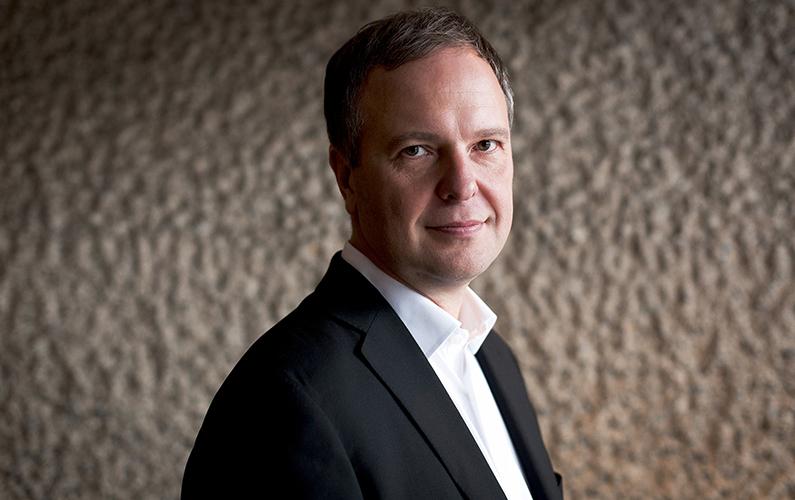How disorienting it is to find century-old works in the concert repertoire of which you can still say “I’ve never heard anything like it”. That must have been the reaction of most audience members last night to Tuscan-German composer Ferruccio Busoni’s 85-minute symphony-concerto for piano, orchestra and male voice choir, since only a few will have caught what classical anoraks tell me was its only other London performance in recent years, at the 1988 Proms.
This misleadingly named Piano Concerto crowned a magnificent triptych of a concert programme centred around the Janus-headed year 1902, which the BBC Symphony Orchestra’s pioneering principal conductor Sakari Oramo presumably structured as the second instalment in his Nielsen symphonies cycle. His daring was rewarded with a nearly full house, at least in the stalls: third time lucky for the BBCSO, whose previous two stunners had very small audiences indeed, though both were as fascinating programme-wise and the conductor of last Friday’s hair-raiser, Jukka-Pekka Saraste, would have been no less electrifying a choice of chief conductor than his fellow Finn. It’s certainly something to have to reorder the list of candidates for “concert of the year” in mid-December.
 Most conventionally late-romantic of the three works was Rachmaninov’s cantata Spring, a difficult work to programme since it calls for full chorus and powerful soloist but only lasts about a quarter of an hour, half the length of the composer’s choral masterpiece The Bells. Yet it anticipates much of the eerie writing there, not least the wordless howling of the winter wind as the baritone soloist unfolds his narrative. Nekrasov’s poem is an unreconstructed piece of macho intent with a happy ending, the gist being “shall I kill my unfaithful wife? Oh no, look, here’s spring, isn’t it lovely”. The role was taken by a voice as incisive and powerful as the knife the protagonist lets drop, vintage Russian baritone Igor Golovatenko. Oramo (pictured above by Benjamin Ealovega) dug deep for vernal sensuousness, even if the BBC Symphony Chorus wasn’t your idiomatic, full-throated Slavic ensemble; the men were to make rich amends at the end of a generous evening.
Most conventionally late-romantic of the three works was Rachmaninov’s cantata Spring, a difficult work to programme since it calls for full chorus and powerful soloist but only lasts about a quarter of an hour, half the length of the composer’s choral masterpiece The Bells. Yet it anticipates much of the eerie writing there, not least the wordless howling of the winter wind as the baritone soloist unfolds his narrative. Nekrasov’s poem is an unreconstructed piece of macho intent with a happy ending, the gist being “shall I kill my unfaithful wife? Oh no, look, here’s spring, isn’t it lovely”. The role was taken by a voice as incisive and powerful as the knife the protagonist lets drop, vintage Russian baritone Igor Golovatenko. Oramo (pictured above by Benjamin Ealovega) dug deep for vernal sensuousness, even if the BBC Symphony Chorus wasn’t your idiomatic, full-throated Slavic ensemble; the men were to make rich amends at the end of a generous evening.
I expected the Nielsen symphony, the masterly Second which in the score goes only by its sobriquet “The Four Temperaments”, to be the highlight of the evening, and it certainly left us exhilarated by the interval. The lovable Dane drew his inspiration from a semi-comic painting in an inn of characters choleric, phlegmatic, melancholy and sanguine, though the end result is much more serious and in the shades of each movement as well as their interconnections Nielsen ends up perhaps drawing a self-portrait of infinite variety. No-one could have drawn playing of more snappy, garish energy for the opening Allegro collerico, with its accents, jabs and dissonances way beyond anything else that was being written in 1902, than Oramo.
If he didn’t quite seem to inscape the mysterious workings of the second movement’s lilting, phlegmatic youth – the composer’s description in his own, incomparable programme note reads like a Raymond Carver short-short story – that may have had something to do with the Barbican’s amplifying tendencies (never sit on the far right facing the orchestra, an acoustic anomaly). The melancholy heart of the work drew big, dark string sound allying Nielsen briefly with his equally original contemporary Sibelius, but there’s nothing anywhere else in music quite like the rollicking bully-boy of the finale who learns ultimate dignity by bitter experience and ends up in the most brilliant vein of Elgar’s Pomp and Circumstance marches – but with typically Scandinavian brevity and humour.
 There was brilliant trumpet work both here and in the Busoni concerto, which struck me – since I’d just come reeling from the Anselm Kiefer exhibition about to end at the Royal Academy – as standing in the same relation to the Nielsen as Kiefer’s cosmic vision does to the profound humanism of late Rembrandt in what must be the other big show of the year. Now read me tying myself in knots trying to get to grips with this maverick monster. The pomp here, unfurled in the odd-numbered movements of the five, is also never exactly pompous, but then a noble heavyweight pianist like Garrick Ohlsson (pictured above), one of the few in the world cut out to play the work, would never let it become so. He sat with perfect poise at the keyboard – a lesson to a couple of young Russians who curl themselves caterpillar-like round the keyboard, not good for the back – effortlessly commanding all the virtuoso rolls and roulades.
There was brilliant trumpet work both here and in the Busoni concerto, which struck me – since I’d just come reeling from the Anselm Kiefer exhibition about to end at the Royal Academy – as standing in the same relation to the Nielsen as Kiefer’s cosmic vision does to the profound humanism of late Rembrandt in what must be the other big show of the year. Now read me tying myself in knots trying to get to grips with this maverick monster. The pomp here, unfurled in the odd-numbered movements of the five, is also never exactly pompous, but then a noble heavyweight pianist like Garrick Ohlsson (pictured above), one of the few in the world cut out to play the work, would never let it become so. He sat with perfect poise at the keyboard – a lesson to a couple of young Russians who curl themselves caterpillar-like round the keyboard, not good for the back – effortlessly commanding all the virtuoso rolls and roulades.
The second and fourth movements throw up fireworks against a louring skyThey imitate the emptiness at the heart of much of Liszt’s bravura without ever quite becoming it. For Busoni is the supreme evader. His themes are either waywardly chromatic or so simple that they hardly seem themes at all. They unfold in baffling sequence, rarely lingering long, but somehow the effect isn’t mannered or second rate, the deeper logic never shattered by surprising breaks like the one after a sudden major-to-minor firework in the hypnotic cortege of the central slow movement.
How is it that Busoni, or at least this performance, holds our attention across a huge span? I still don’t know. The second and fourth movements certainly throw up fireworks against a louring sky, like a Mahler scherzo but with the flavour of Italian cantilenas and street songs, again never settling for long. Here, perhaps, we could have done with a Puck rather than Ohlsson’s pachyderm attired in gorgeous silks; perhaps he could have taken a break and handed over the piano to a more chameleonic pianistic intelligence like Stephen Hough, present in the audience. But then I doubt if even Hough could have managed the insane cadenza of the “All’Italiana: Tarantella” movement, of which – typically – Ohlsson chose the longer version.
After this came genuine incandescence and strangeness in the final "Cantico", the BBC Symphony Chorus gentlemen sounding like the richest of professional choirs as they intoned the universal hymn of Adam Oehlenschläger’s Aladdin, a kind of Danish Magic Flute. I bought it; so, to judge from the standing ovation, did most of the audience. Despite its minor flaws, an absolute corker of a concert: magnificent, unrepeatable – except, perhaps, at the Proms.















Add comment